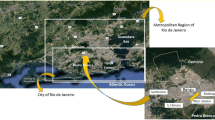Abstract
This study investigates the potential factors that contribute to frequent high levels of ozone in Bangu, one of the most critical areas in the city of Rio de Janeiro, regarding ozone levels and air quality. Speciated non-oxygenated volatile organic compounds (VOCs) were measured using method TO-15 (US EPA). The measured concentrations and kinetic and mechanistic analysis of VOC reactivity showed that alkanes were the most important compounds. Ozone concentrations were simulated for a base case representing a day with high ozone levels. Simulated results and statistical multivariate analysis showed that the high ozone concentrations did not seem to be closely related to local emissions but rather were related to pollutant transport and low measured NOx levels and were triggered by photochemical activity. The differences between weekdays and weekends were also investigated, showing that ozone concentrations were also higher during weekends, mainly on Sunday, when the diesel heavy vehicle fleet was reduced and lower NO emissions were observed. The VOC/NOx ratios correspond to a VOC-limited process, which leads to higher ozone concentrations under low NOx conditions.







Similar content being viewed by others
References
Atkinson, R. (2000). Atmospheric chemistry of VOCs and NOx. Atmospheric Environment, 34, 2063–2101.
Carter, W.P.L. (1990). A detailed mechanism for the gas-phases atmospheric reactions of organic compounds. Atmospheric Environment, 24, 481-518.
Carter, W. P. L. (1994). Development of ozone reactivity scales for volatile organic compounds. Journal of the Air and Waste Management Association, 44, 881–899.
Carter, W. P. L. (2010). Development of the SAPRC-07 chemical mechanism and updated ozone reactivity scales. Atmospheric Environment, 44, 5324–5335.
Carter, W.P.L. (2016) SAPRC Atmospheric chemical mechanisms and VOC reactivity scaleshttp://www.engr.ucr.edu/~carter/SAPRC/.
Carter, W.P.L. (2000b) Additions and corrections to the SAPRC-99 maximum incremental reactivity (MIR) scale. Report to the California Air Resources Board, Sacramento, CA. CE-CERT, University of California, Riverside, CA.
Carter, W.P.L. (2000a) Documentation of the SAPRC-99 Chemical Mechanism for VOC Reactivity Assessment. Final Report to California Air Resources Board Contract n° 92–329 and, (in part 95).
CONAMA (1990). http://www.mma.gov.br/port/conama/res/res90/res0390.html.
DENATRAN (2019). http://www.denatran.gov.br/estatistica/639-frota-2019.
Geraldino, C. G. P., Martins, E. M., Silva, C. M., & Arbilla, G. (2017). Analytical investigation of ozone episodes in Bangu, Rio de Janeiro. Bulletin of Environmental Contamination and Toxicology, 98, 632–637.
Gery, M.W., Crouse, R.R. (1990) User’s guide for executing OZIPR. U.S. Environmental Protection Agency. Research Triangle Park, N.C., EPA-9D2196NASA.
Gioda, A., Oliveira, R. C. G., Cunha, C. L., & Corrêa, S. M. (2018). Understanding ozone formation at two islands of Rio de Janeiro, Brazil. Atmospheric Pollution Research, 9, 278–288.
Goyal, S. K., Ghatge, S. V., Nema, P., & Tamhane, S. M. (2006). Understanding urban vehicular problem vis-a-vis ambient air quality – case study of a megacity (Delhi, India). Environmental Monitoring and Assessment, 119, 557–569.
Kursa, M. B., & Rudnicki, W. R. (2010). Features selection with the Boruta package. Journal of Statistical Software, 36(11), 1–13.
HYSPLIT (2019) https://www.ready.noaa.gov/HYSPLIT_traj.php.
IBGE (2011) http://cidades.ibge.gov.br/xtras/perfil.php?lang=&codmun=33045.
Martins, E. M., Nunes, A. C. L., & Corrêa, S. M. (2015). Understanding ozone concentrations during weekdays and weekends in the urban area of the city of Rio de Janeiro. Journal of the Brazilian Chemical Society, 26, 1967–1975.
Orlando, J. P., Alvim, D. S., Yamazaki, A., Corrêa, S. M., & Gatti, L. V. (2010). Ozone precursors for the São Paulo metropolitan area. The Science of the Total Environment, 408, 1612–1620.
RIO DE JANEIRO (2011). http://www.armazemdedados.rio.rj.gov.br/.
R (2019) The R Project for Statistical computing. https://www.r-project.org/.
Seinfeld, J., & Pandis, S. (2016). Atmospheric chemistry and physics: from air pollution to climate change. John Wiley & Sons Inc..
Serguel, R. J., Morales, R. G. E., & Leiva, M. A. (2012). Ozone weekend effect in Santiago, Chile. Environmental Pollution, 162, 72–79.
Silva, C. M., Silva, L. L., Corrêa, S. M., & Arbilla, G. (2018). A minimum set of ozone precursor volatile organic compounds in an urban environment. Atmospheric Pollution Research, 9, 369–378.
Silva, C. M., Souza, E. C. C. A., Silva, L. L., Oliveira, R. L., Correa, S. M., & Arbilla, G. (2016a). Volatile organic compounds in the atmosphere of the botanical garden of the city of Rio de Janeiro: a preliminary study. Bulletin of Environmental Contamination and Toxicological, 97, 653–658.
Silva, D. B. N., Martins, E. M., & Corrêa, S. M. (2016b). Role of carbonyls and aromatics in the formation of tropospheric ozone in Rio de Janeiro, Brazil. Environmental Monitoring and Assessment, 188, 289–230.
Silva, C. M., Siciliano, B., Carvalho, N., Corrêa, S. M., & Arbilla, G. (2019). Simple photochemical model as a tool for air quality control. Química Nova, 42, 273–282.
SMAC (2016). http://www.rio.rj.gov.br/dlstatic/10112/3252594/4114836/RelatorioMonitorar20112012.pdf. Accessed 20 Nov 2019.
Tonnesen, G. S. (2000). User’s Guide for Executing OZIPR Version 2.0. North Caroline: U.S.EPA.
U.S.EPA. Compendium Method TO-15 (1999) Determination of volatile organic compounds (VOCs) in air collected in specially-prepared canisters and analyzed by gas chromatography/ mass spectrometry (GC/MS). Center for Environmental Research Information.
Wolff, G. T., & Korsog, P. E. (2012). Ozone control strategies based on the ratio of volatile organic compounds to nitrogen oxides. Journal of the Air and Waste Management Association, 42, 1173–1177.
Acknowledgments
The authors acknowledge data provided by Secretaria Municipal de Meio Ambiente (SMAC) and the NOAA Air Resources Laboratory for the provision of HYSPLIT (READY website).
Funding
The study was funded in part by Fundação de Amparo à Pesquisa do Estado do Rio de Janeiro (FAPERJ), Conselho Nacional de Desenvolvimento Científico e Tecnológico (CNPq), Coordenação de Aperfeiçoamento de Pessoal de Nível Superior (CAPES), and Centro de Pesquisas Leopoldo Américo Miguez de Mello (CENPES/Petrobras).
Author information
Authors and Affiliations
Corresponding author
Additional information
Publisher’s note
Springer Nature remains neutral with regard to jurisdictional claims in published maps and institutional affiliations.
FAPERJ: E-26/202.793/2015 Fundação Carlos Chagas Filho de Amparo à Pesquisa do Estado do Rio de Janeiro
Electronic supplementary material
ESM 1
(DOCX 233 kb)
Rights and permissions
About this article
Cite this article
Geraldino, C.G.P., Arbilla, G., da Silva, C.M. et al. Understanding high tropospheric ozone episodes in Bangu, Rio de Janeiro, Brazil. Environ Monit Assess 192, 156 (2020). https://doi.org/10.1007/s10661-020-8119-3
Received:
Accepted:
Published:
DOI: https://doi.org/10.1007/s10661-020-8119-3




